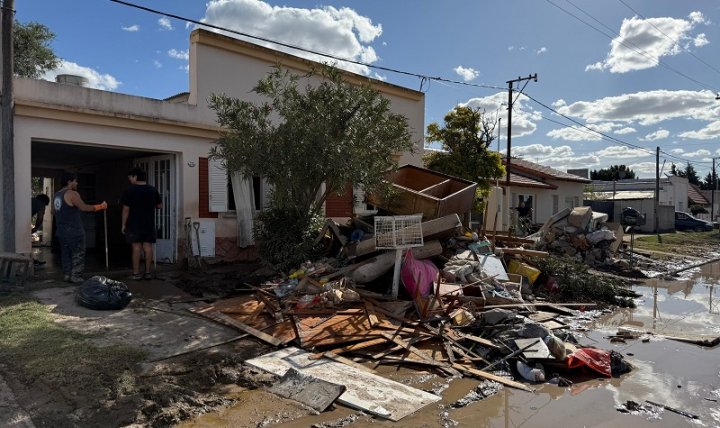
On March 7, 2025, Bahía Blanca was razed by an unprecedented storm. In a few hours, the streams overflowed, the streets became unstoppable torrents and hundreds of families lost everything. The city was submerged underwater but a force and solidarity emerged that impacted everyone.
Days later, when traveling those same streets covered with mud, rubble and the material remains that the neighbors took from their homes, the stories were shocking. “The first thing was to get the boys and grandparents, then what could be saved. But the water went up quickly, it didn’t give time to anything,” said Juan, a neighbor of engineer White. Many, seeing that the official help did not arrive, launched to rescue others with what they had at hand: boats, kayaks, to surf tables. The spontaneous organization was the difference between life and death for many, especially older adults and children.
Water dragged cars, light posts and whole houses, but also garbage and overwhelming sewers. In the low neighborhoods, the poorest in the city, pollution further aggravated the disaster. In engineer White, seeing that the water did not lower, a group of neighbors along with firefighters toured the industrial zone in search of drain gates and found them blocked by a tree. “This is a municipal work, it is not firefighters, much less neighbors,” said a live volunteer firefighter for the C5N cameras and replicated by the daily left.

Days later, the mayor tried to deny him at a press conference and this aroused even more anger from the people. In each testimony, the lie of the mayor of Union for the country arose, and the neighbors themselves were responsible for sending us the videos of how the tapas had opened. A new publication with these tests was even more viral, “who are you going to believe, the mayor or the firefighter?” They sentenced in the comments.
The outrage was widespread because in the whole city it was the population who had to make ditches inside the channels, uncover drains and get ready to clean, disinfect and try to lower the humidity of homes. A week later when some streets rain again they continued with the covered drains. Not only did it happen in the most deprived neighborhoods, in the center of the city the lack of maintenance, poor infrastructure and the complete disaster of sewage waste management that made water not only drag mud but also fecal matter were also evidenced.

While the state looked the other way, solidarity from below was the real answer. In Coronel Cerri and other isolated neighborhoods, the help came first from neighbors and volunteers. From nearby cities, people undoubtedly made themselves available.
A group of health workers put together a “health and care post” in the most beaten neighborhoods: nurses, doctors, psychologists and volunteers attended emergencies and collaborated in preventing diseases. This primary care without falsifying the facts was fundamental, because the authorities preferred to hide the possible diseases to which the neighbors were exposed to show the return to work and schools, even when social and health conditions were not given.
Laura Cano, a doctor at Cestino Hospital and Buenos Aires deputy of the PTS-FITU, headed the initiative. In the Chamber of Deputies, he contrasted the official propaganda of the “Save who can” with reality: without the popular organization, the catastrophe would have been even worse. He denounced the lack of water works and the city model at the service of large companies, not their people.
This disaster was not a climatic tragedy. It was the result of decades of abandonment, urbanization without planning and a collapsed infrastructure. How many specialist warnings were ignored? How many more rains until something changes the root?
The mayor announced that 400 billion pesos will be needed to rebuild the city. But its “reconstruction” does not mention sewers, housing destroyed or losses of working families. Its priority is another: reactivate the petrochemical pole and the port as soon as possible, return to the “normality.”
That normality was the one that took us here and the one that today is in question. Solidarity and organization are the best tools that neighbors have. Why not put that force too to change everything? The reconstruction of Bahía Blanca should not be only material, but also social and political, and has to be at the service of the great working majorities who put themselves in motion solidarity. Affect the multimillion -dollar profits of the companies of the petrochemical pole and the port is the first step.
Camera and interviews: Javier brother
Assembly and edition: Micaela etchevest, Estefy Lopre, Matias Gali
Production: Miguel Iademarco
Source: www.laizquierdadiario.com

